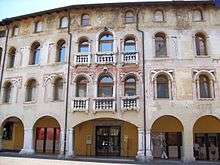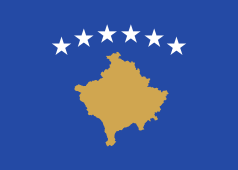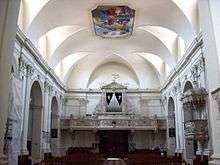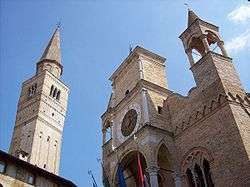Pordenone
| Pordenone | |
|---|---|
| Comune | |
| Comune di Pordenone | |
|
Pordenone City Hall and Campanile | |
 Pordenone Location of Pordenone in Italy | |
| Coordinates: 45°58′N 12°39′E / 45.967°N 12.650°ECoordinates: 45°58′N 12°39′E / 45.967°N 12.650°E | |
| Country | Italy |
| Region | Friuli-Venezia Giulia |
| Province / Metropolitan city | Pordenone (PN) |
| Frazioni | Borgomeduna, Rorai Grande, San Gregorio, Torre, Vallenoncello, Villanova di Pordenone |
| Government | |
| • Mayor | Alessandro Ciriani (from 20 June 2016) |
| Area | |
| • Total | 38.2 km2 (14.7 sq mi) |
| Elevation | 24 m (79 ft) |
| Population (31 December 2014) | |
| • Total | 51,632 |
| • Density | 1,400/km2 (3,500/sq mi) |
| Demonym(s) | Pordenonesi |
| Time zone | CET (UTC+1) |
| • Summer (DST) | CEST (UTC+2) |
| Postal code | 33170 |
| Dialing code | 0434 |
| Patron saint | Saint Mark |
| Saint day | April 25[1] |
| Website | Official website |
Pordenone [pordeˈnoːne] ![]() listen (Venetian and Friulian: Pordenon) is the main comune of Pordenone province of northeast Italy in the Friuli-Venezia Giulia region.
listen (Venetian and Friulian: Pordenon) is the main comune of Pordenone province of northeast Italy in the Friuli-Venezia Giulia region.
The name comes from Latin Portus Naonis, meaning 'port on the Noncello (Latin Naon) River'.
History
Pordenone was created in the High Middle Ages as a river port on the Noncello, with the name Portus Naonis. In the area, however, there were already villas and agricultural settlements in the Roman age.
In 1278, after having been administrated by several feudatories, the city was handed over to the Habsburg family, forming an Austrian enclave within the territory of the Patriarchal State of Friuli. In the 14th century, Pordenone grew substantially due to the flourishing river trades, gaining the status of city in December 1314.
In 1514, it was acquired by the Republic of Venice, even if until 1537 the town was ruled by the feudal family d'Alviano. Under Venice a new port was built and the manufacturers improved.

After the Napoleonic period, Pordenone was included in the Austrian possessions in Italy (Kingdom of Lombardy-Venetia). The railway connection, including Pordenone railway station, and the construction of the Pontebbana road brought on the decline of the port, but spurred substantial industrial development (especially for the working of cotton). Pordenone was annexed to Italy in 1866.
The cotton sector decayed after the damage of World War I and failed completely after the 1929 crisis. After World War II, the local Zanussi firm became a world giant of household appliances, and in 1968, Pordenone became capital of the province with the same name, including territory belonging to Udine.
After World War II, Pordenone, as well as the rest of Friuli-Venezia Giulia, became a garrison for many military units, in order to prevent a Soviet invasion from the east.
The heavy military presence boosted the economy of the once-depressed area.
Pordenone is as now garrison of the 132nd Armored Brigade "Ariete".
Geography
The territory of Pordenone is located in the lowlands of the Po-Venetian Valley, south of Venetian Alps and the Alpine foothills of Friuli.
The lowlands of Pordenone is characterized by an abundance of water and by the "phenomenon" of resurgence.
Climate
Climate in this area has mild differences between highs and lows, and there is adequate rainfall year-round. The Köppen Climate Classification subtype for this climate is "Cfb" (Marine West Coast Climate/Oceanic climate).[2]
| Climate data for Pordenone | |||||||||||||
|---|---|---|---|---|---|---|---|---|---|---|---|---|---|
| Month | Jan | Feb | Mar | Apr | May | Jun | Jul | Aug | Sep | Oct | Nov | Dec | Year |
| Average high °C (°F) | 7 (44) |
2 (36) |
12 (53) |
17 (62) |
21 (69) |
25 (77) |
28 (82) |
27 (80) |
24 (75) |
18 (64) |
12 (53) |
8 (46) |
17 (62) |
| Average low °C (°F) | −1 (30) |
0 (32) |
2 (35) |
6 (42) |
11 (51) |
14 (57) |
16 (60) |
16 (60) |
13 (55) |
8 (46) |
3 (37) |
0 (32) |
7 (44) |
| Average precipitation mm (inches) | 71 (2.8) |
84 (3.3) |
109 (4.3) |
160 (6.3) |
109 (4.3) |
142 (5.6) |
109 (4.3) |
107 (4.2) |
104 (4.1) |
132 (5.2) |
213 (8.4) |
142 (5.6) |
1,483 (58.4) |
| Source: Weatherbase [3] | |||||||||||||
Demographics
Local languages and dialects
In ancient times, the Friulian language was spoken in Pordenone. Under the Venetian rule the Venetian language – closer to modern standard Italian – was subsequently introduced in a form which developed into the modern days Pordenone dialect. The town is surrounded by Friulian-speaking communities (though Venetian features can be found there as well).[4]
However, Friulian is protected in town in accordance with the Regional Law of December 18, 2007, n. 29, "Norms for the protection, promotion and enhancement of the Friulian language".[5]
Ethnic minorities
Foreign citizens living in Pordenone amount to 8,001 units, making out 15.5% of the town population. The ten largest ethnic minorities are listed as follows:[6]
-
 Romania, 1,896
Romania, 1,896 -
 Ghana, 1,158
Ghana, 1,158 -
 Albania, 1,129
Albania, 1,129 -
 Bangladesh, 434
Bangladesh, 434 -
 Ukraine, 299
Ukraine, 299 -
 Morocco, 290
Morocco, 290 -
 Moldova, 238
Moldova, 238 -
 People's Republic of China, 200
People's Republic of China, 200 -
 Pakistan, 197
Pakistan, 197 -
 Kosovo, 162
Kosovo, 162
Landmarks

Religious buildings
- Cathedral of St. Mark (Duomo) was built from 1363 in Romanesque-Gothic style and restored in the 16th and 18th centuries. It houses a famous fresco of San Rocco and an altarpiece depicting the Virgin of Mercy by the native Renaissance painter Giovanni Antonio de' Sacchis (commonly known as Il Pordenone). Also inside the church are preserved the baptistery and the font by Giovanni Antonio Pilacorte, some fragments of frescoes of the circle of Gentile da Fabriano and a painting by Tintoretto. It has a 79-metre (259 ft) bell tower.
- Church of St. Mary of the Angels, also known as Church of the wooden Christ. The church was built in 1309 and it is characterized by an entrance portal in Istrian stone by Giovanni Antonio Pilacorte. Inside the sacred building they are kept a crucifix dating from the 1466 of Johannes Teutonicus and remains of a cycle of fourteenth-century frescoes. They are worthy of mention: the Saint Barbara by Gianfrancesco da Tolmezzo and the Our Lady of Sorrows, fresco from the first half of the fourteenth century. On the left wall of the church it is possible to admire a Madonna of humility(fourteenth-century fresco of the school of Vitale da Bologna)
- Parish Church of San George. Neoclassical church, characterized by the nineteenth-century bell tower, column Doric (architect Giovanni Battista Bassi).
- The church of the Santissima Trinità ("Holy Trinity"), alongside the Noncello river. It has an octagonal plant and frescoes by Giovanni Maria Calderari, pupil of Il Pordenone.
- Church of Blessed Odoric of Pordenone, built by architect Mario Botta in 1990–1992.[7]
- Church of S. Ulderico, located in Villanova suburb. Contains frescoes by Il Pordenone and the font and baptistery are by Giovanni Antonio Pilacorte.
- Parish Church of St. Lawrence Martyr, in the frazione of Roraigrande, contains the baptismal font of Renaissance sculptors Donato and Alvise Casella. Inside it is possible to admire a cycle of frescoes by Giovanni Antonio de 'Sacchis
Secular buildings
The town has many mansions and palaces, in particular along the ancient "Greater Contrada", today Corso Vittorio Emanuele II (wonderful example of Venetian porticoes and called by some small "waterless Grand Canal"). Below is a list of the most important in terms of architectural and artistic.
- The Gothic Communal Palace (1291–1395). The clock-tower of the loggia, designed by painter Pomponio Amalteo, was added in the 16th century to the main building.
- Palazzo Ricchieri: Built in the 13th century as a house fortress with a tower, it was rebuilt to house the Ricchieri family. It now houses the Civic Art Museum.
- Palazzo Polacco – Barbarich – Scaramuzza.

- Palazzo Rorario – Spelladi – Silvestri, headquarters of the municipal gallery "Harry Bertoia".
- Palazzo Mantica – Cattaneo.
- Palazzo Mantica.
- Palazzo Gregoris.
- Casa Gregoris – Bassani.
- Palazzo Varmo – Pomo, also known as House of the Captains.
- Palazzo Crescendolo – Milani.
- Palazzo Popaite – Torriani – Policreti.
- Casa Simoni.
- Casa Pittini.
- Palazzo Domenichini – Varaschini.
- Palazzo Rosittis.
- Palazzo De Rubeis.
Castles
- Castello di Torre (late 12th century), residence of the Ragogna family and now seat of the Western Friuli Archaeological Museum. It was assaulted in 1402 by Imperial troops, who destroyed the castle. A few years later a tower was rebuilt.
- Castle of the ancient town of Pordenone, located in Piazza della Motta, now a prison.
Archaeological site
- Roman Villa of Torre, remains of a patrician villa discovered in the 1950s.
Venetian villas
In the city there are nine buildings protected by the Regional Institute Venetian Villas (IRVV). Worthy of note are:
- Villa Cattaneo, the Gaspera, (seventeenth century), which is characterized by a high arched pediment (Villanova of Pordenone);
- Villa Cattaneo, Cirielli Barbini, probably dating back to 700 (Vallenoncello of Pordenone).
Industrial archeology
The urban conglomerate of Pordenone is characterized by the presence of the ruins of the industries dating back to the nineteenth century, examples of industrial archeology.
Transport
Bus
The local transportation company in Pordenone is called ATAP. It provides ten "urban routes", which serve the municipal territory and all surrounding neighborhoods, and several "extraurban routes" which cover the whole Pordenone province, about twenty of them connecting the town directly with other destinations, including Aviano, the Venice International Airport and Lignano.[8]
Railway
Pordenone railway station, opened in 1855, is located on the Venice–Udine railway. Although it is not a junction or terminal station, it is used by a great many passengers ( 3 million/year).
Air
Venice Airport is the nearest air connectivity, which is approximately 80 kilometres (50 miles) away from the city.
Education
As concerns public general education, Pordenone hosts nine kindergartens, twelve primary schools, four first grade secondary schools, the Flora Professional School of Commerce, Culinary Studies, Hospitality Training and Social Services, the Zanussi Professional School of Industry and Crafts, the Matiussi High School of Economics, two Schools of Technologies (J.F. Kennedy and Pertini). The "licei" (grammar schools) in town are Grigoletti Scientific High School and Leopardi-Majorana High School of Classics and Science.[9] Alongside public schools, some private schools also exist in Pordenone.
Pordenone hosts a local branch of the University of Trieste, whose didactic includes a double degree Master study program in Production Engineering and Management with the University of Lippe, Germany.[10] Other curricula include B.Sc. courses in Multimedial Sciences&Technologies and Nursing and a M.Sc. course in Multimedia Communication and IT, offered by the University of Udine.
The university building on Via Prasecco was designed by Japanese architect Toyo Ito.[11]
Sport
Pordenone is home to the Ottavio Bottecchia Stadium, on via dello Stadio, a multipurpose 3,000-seats facility serving as a soccer field for the local team, Pordenone Calcio, and as velodrome used for both national and international track cycling competitions.[12] In 2001, the facility hosted one round of the UCI Track Cycling World Cup.[13] It is considered as one of the most important outdoor velodromes in the world.[14]
The site of the stadium includes tennis courts as well as an athletics field.
Culture
Sleeping Beauty awakes. This industrial town in Friuli has put on a new dress and got rid of its past Cinderella image and its ugly duckling complex. Pordenone now banks on culture, also to bring together people from more than one-hundred ethnic groups living in town
—Elena Del Savio, quiTOURING.[15]
Literature
Pordenone has hosted every year for more than a decade the book festival pordenonelegge.it, which includes book stalls being placed all over the town center as well as interviews with Italian and international authors and lectures by journalists and scholars.[16]
Film
Pordenone has been the primary host to the Giornate del cinema muto, a festival of silent film, since 1981, excepting an eight-year lapse after the host theater, Cinema-Teatro Verdi, was torn down. The nearby town of Sacile hosted the festival from 1999 to 2006.
Pordenone is also home to the FMK International Short Film Festival.[17]
Music
In the 1970s, Pordenone was the hub of the Italian punk rock scene, due to its closeness to the Aviano Air Base.[18] Alternative rock band Tre Allegri Ragazzi Morti is based here.
Since 1991, the town has hosted each summer the Pordenone Blues Festival, expanding its scope in 2010 encompassing the fields of performing arts, literature and visual arts.[19][20] Notable guests over the years include Ronnie Jones and Ana Popović. Performers playing at this festival include artists based in Italy, Germany, Slovenia, Spain, Serbia, Croatia, Hungary and other countries.
Museums and galleries
Diocesan Museum of Sacred Art – Diocese of Concordia-Pordenone
Located in the Pastoral Activities Centre, designed by Othmar Barth (1988), retains a remarkable artistic heritage from churches and religious buildings of the Roman Catholic Diocese of Concordia-Pordenone.
Town Art Museum
The museum is housed in the Palazzo Ricchieri, an important place to understand the art of Veneto and Friuli-Venezia Giulia. In it houses works by various painters, such as Pordenone, P. Amalteo, Varotari, Pietro della Vecchia, O. Politi and Michelangelo Grigoletti.
Archaeological Museum of Western Friuli
The museum, housed since 2006 in the ancient castle of the Torre of Pordenone, the last residence of Count Giuseppe di Ragogna, illustrates the archaeological heritage of the Province of Pordenone. Of particular significance are the finds from the caves Pradis and pile-dwelling (or stilt house)of Palù di Livenza (UNESCO World Heritage Site – Prehistoric pile dwellings around the Alps).
Gallery of Modern and Contemporary Art "Armando Pizzinato"
The museum is housed in a Venetian villa of the city park, once owned by industrialist Galvani. In its rooms it houses paintings by Mario Sironi, Renato Guttuso, Corrado Cagli, Alberto Savinio, Filippo de Pisis, Giuseppe Zigaina, Armando Pizzinato and many others.
Newspapers
Two Italian daily newspapers have a local edition:
International relations
Twin towns — Sister cities
Pordenone is twinned with:
-
 Spittal an der Drau, Austria, since 1987
Spittal an der Drau, Austria, since 1987 -
 San Martín, Argentina, since 2003
San Martín, Argentina, since 2003 -
 Irkutsk, Russia, since 2005
Irkutsk, Russia, since 2005 -
 Ōkawa, Japan
Ōkawa, Japan
Notable People
This list is arranged alphabetically by surname.
A–F
- Pomponio Amalteo
- ELizabeth Ashwood
- Mauro Baron
- Giovanni Battista Bassi (Pordenone 1792 – Santa Margherita del Gruagno 1879)
- Rudy Buttignol, Canadian television executive & entrepreneur as President & CEO of British Columbia's public broadcaster, Knowledge Network and BBC Kids.
- Donato Casella, Renaissance sculptor.
- Pietro Capretto (Pordenone 1427 – 1504)
- Pietro Cesari (Pordenone 1849 – Milan 1922), an important opera singer of the nineteenth century
- Giovanni Battista Cossetti, musician and composer
- Giovanni Francesco Fortunio (Pordenone, 1460–70 – 1517), author of the first grammar of fourteenth-century Italian (as used by Tuscan authors Dante, Petrarch, Boccaccio), used as a guideline of correct Italian for the sixteenth century élite.
G–M
N–Z
- Gaspare Narvesa, a local painter of the seventeenth century
- Luca Rosetti
- Ottorino Simoni
- Rudy Stivella
- Davide Toffolo
- Alessia Trost
- Giovanni Maria Zaffoni
References
- ↑ Due to conjunction with a National Holiday, the Local holiday is held on September 8
- ↑ Climate Summary
- ↑ "Weatherbase.com". Weatherbase. 2013. Retrieved on June 19, 2013.
- ↑ Rizzolati, Piera (1997), "Sette secoli di Lingua: Pordenone tra veneto e friulano", in Vianello Libri, Dalla serenissima agli Asburgo: Pordenone Gemona, l'antica strada verso l'Austria (in Italian), pp. 160–161, ISBN 88-7200-041-6
- ↑ http://www.arlef.it/it/risorse/toponomastica/2
- ↑ Italian Institute of Statistics (ed.). "Popolazione residente straniera al 31 dicembre 2014 per Nazionalità" (in Italian). Retrieved May 31, 2016.
- ↑ "Sito web http://www.botta.ch/Page/Sa%201992_124_Pordenone_it.php "Chiesa parrocchiale Beato Odorico da Pordenone, Italia 1987–1992"". External link in
|title=(help) - ↑ http://www.atap.pn.it/en/index.aspx
- ↑ http://www.comuni-italiani.it/093/033/scuole/
- ↑ http://www.cspn.units.it/en/
- ↑ "Il genio di Ito, da Tokyo a Pordenone". Quotidiano "il Messaggero Veneto". 11 December 2004.
- ↑ http://www.pordenonecalcio.com/stadio-bottecchia-informazioni-generali/
- ↑ http://www.demetrio.pn.it/tre-giorni.html
- ↑ http://web.archive.org/web/20140820015637/http://www.amicidellapista.com/il-velodromo/
- ↑ Elena Del Savio, "La bella risvegliata. Con un passato da cenerentola e il complesso del brutto anatroccolo, la città industriale friulana si è messa un vestito nuovo. E punta sulla cultura, anche per unire le sue cento e più nazionalità":, in quiTOURING il mensile del turismo più diffuso in Italia – Marzo 2007 – ANNO XXXVIII -N. 3., Touring Editore, March 2007, page 85.
- ↑ http://www.pordenonelegge.it/
- ↑ http://fmkfestival.it/2014/
- ↑ Mazzocut, Mauro "Cloned". The Great Complotto Pordenone. Biblioteca Civica di Pordenone.
- ↑ http://www.pordenonebluesfestival.it/?page_id=12
- ↑ http://www.pordenonewithlove.it/it/eventi-news/o/643/Pordenone-Blues-Festival
External links
- Official website (Italian)
- Town Art Museum
- Western Friuli Archaeological Museum
- Town Science Museum
- Castello di Torre
